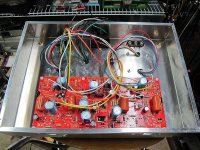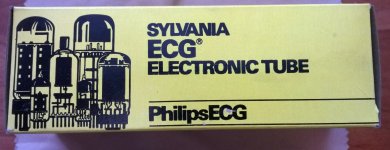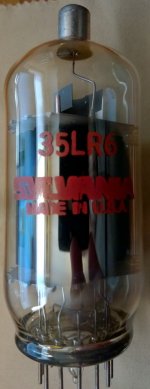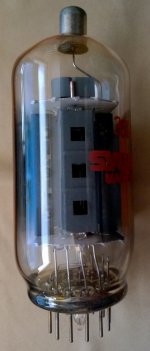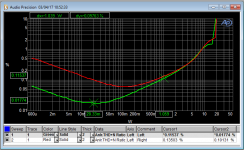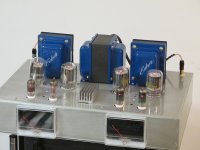Live ... again ..... testing
Definitively stock power transformer is better, there’s plenty of power and I feel more comfortable with voltage.
These days I’m testing different combinations of 6HJ5 and 6CB6 brands, have RCA and Mullard (International) for 6HJ5 , Philips and Sylvania for 6CB6.
Using "good" loudspeaker, self build Cornu with Jordan's Eikona.
Now the problem is that the amp produces an (almost inaudible) buzz that is annoying and after some time (15-20 minutes) gives me a mild headache.
Don’t know how is possible that something barely audible makes me feel uncomfortable and gives headache….
Probably it depends on optimize the balancing of channels, or changing the tubes….that's what I'm working it these days.
On other side working on the case, Ikea baking tin is made of strong inox…..
Definitively stock power transformer is better, there’s plenty of power and I feel more comfortable with voltage.
These days I’m testing different combinations of 6HJ5 and 6CB6 brands, have RCA and Mullard (International) for 6HJ5 , Philips and Sylvania for 6CB6.
Using "good" loudspeaker, self build Cornu with Jordan's Eikona.
Now the problem is that the amp produces an (almost inaudible) buzz that is annoying and after some time (15-20 minutes) gives me a mild headache.
Don’t know how is possible that something barely audible makes me feel uncomfortable and gives headache….
Probably it depends on optimize the balancing of channels, or changing the tubes….that's what I'm working it these days.
On other side working on the case, Ikea baking tin is made of strong inox…..
Nice to see other people are still building this amp. I just ordered a board and am still trying to sort out some of the pieces. I posted a question in the power supply section of the forum, but maybe someone here can help me out.
http://www.diyaudio.com/forums/power-supplies/304522-power-supply-engineers-amplifier.html
http://www.diyaudio.com/forums/power-supplies/304522-power-supply-engineers-amplifier.html
700 volts is probably too much for the 6HJ5's. They will eat the voltage OK, but they need about 30 mA of bias current in this amp to sound good. That puts the tube dissipation at 18 watts per tube with 600 volts on the plates, which is OK, but about as hot as you want to run them at idle since the current goes up when you run audio through the amp. 700 volts will run the tubes at 21 watts each at idle.
Whatever transformers you use, do not run the second transformer on the output of the voltage regulator. Any issues with peak currents, momentary overloads.... will result in the aroma of fried parts.....like mosfets. Connect the CT of your second power transformer to the positive end of C6. If you have the filter cap on the second transformer wired as shown in your schematic it must be rated for the entire B+ voltage (700+ volts). Move the negative end to the CT of the second transformer.
PRR mentions that the original power transformer is only rated for 200 mA. This is marginal since the amp will idle at about 140 ma (4 X 30 mA + 4 X 5 mA). If you plan to listen to music at a reasonable level through reasonably efficient speakers it should be OK. Things like cranking something loud to the edge of clipping and leaving it to play at that level for hours, or plugging a guitar preamp into it, and setting it on KILL, would require a larger current margin. I have done both of these with my amp and it still works today with the original tubes in it.
Whatever transformers you use, do not run the second transformer on the output of the voltage regulator. Any issues with peak currents, momentary overloads.... will result in the aroma of fried parts.....like mosfets. Connect the CT of your second power transformer to the positive end of C6. If you have the filter cap on the second transformer wired as shown in your schematic it must be rated for the entire B+ voltage (700+ volts). Move the negative end to the CT of the second transformer.
PRR mentions that the original power transformer is only rated for 200 mA. This is marginal since the amp will idle at about 140 ma (4 X 30 mA + 4 X 5 mA). If you plan to listen to music at a reasonable level through reasonably efficient speakers it should be OK. Things like cranking something loud to the edge of clipping and leaving it to play at that level for hours, or plugging a guitar preamp into it, and setting it on KILL, would require a larger current margin. I have done both of these with my amp and it still works today with the original tubes in it.
Nice to see other people are still building this amp. I just ordered a board and am still trying to sort out some of the pieces. I posted a question in the power supply section of the forum, but maybe someone here can help me out.
http://www.diyaudio.com/forums/power-supplies/304522-power-supply-engineers-amplifier.html
Wouldn't it be easier to mod Pete's new 6HJ5 monoblock boards for high power. That way, you can use separate power transformers, which would be easy to source from Edcor.
jeff
If anyone by chance is looking for 35LR6s, I just got 8 Sylvania from Roy and Dale but unfortunately need to turn them around again as our "accounts" have been hacked by a not so nice daughter/step-daughter to the tune of $2500. So I am offering 8 brand new Sylvania for $60 and I pay shipping. At 57yo, I should not have to deal with this stuff.....
Ray
Ray
Attachments
700 volts is probably too much for the 6HJ5's. They will eat the voltage OK, but they need about 30 mA of bias current in this amp to sound good. That puts the tube dissipation at 18 watts per tube with 600 volts on the plates, which is OK, but about as hot as you want to run them at idle since the current goes up when you run audio through the amp. 700 volts will run the tubes at 21 watts each at idle.
Whatever transformers you use, do not run the second transformer on the output of the voltage regulator. Any issues with peak currents, momentary overloads.... will result in the aroma of fried parts.....like mosfets. Connect the CT of your second power transformer to the positive end of C6. If you have the filter cap on the second transformer wired as shown in your schematic it must be rated for the entire B+ voltage (700+ volts). Move the negative end to the CT of the second transformer.
PRR mentions that the original power transformer is only rated for 200 mA. This is marginal since the amp will idle at about 140 ma (4 X 30 mA + 4 X 5 mA). If you plan to listen to music at a reasonable level through reasonably efficient speakers it should be OK. Things like cranking something loud to the edge of clipping and leaving it to play at that level for hours, or plugging a guitar preamp into it, and setting it on KILL, would require a larger current margin. I have done both of these with my amp and it still works today with the original tubes in it.
Thanks for the insight; I kind of thought 700V was a little high, and 200mA a little low. I will research options further. I was originally thinking of 700V as a way to get the power I want out of 5k ohm 100W Hammond OPTs, as they are available cheaper to me than anything else I have found of comparable quality/power.
Wouldn't it be easier to mod Pete's new 6HJ5 monoblock boards for high power. That way, you can use separate power transformers, which would be easy to source from Edcor.
jeff
I am considering that now; when I was recently looking up which amp to build, the MB had just come out, and there wasn't much info about it. I have more knowledge from reading the forum that I can probably figure it out with some help along the way if I decide to make the switch to the MBs.
Another consideration was the initial cost, as 2 MBs seemed much more expensive, but with all the power requirements (desires) I have, the original budget has long gone out the window.
I had thought about making high powered monoblocks as well but I haven't looked too hard at the transformers edcor offers to see if I can find one off the shelf for the project.
I had thought about making high powered monoblocks as well but I haven't looked too hard at the transformers edcor offers to see if I can find one off the shelf for the project.
Without going custom, looks like this is it from Edcor: EDCOR - XPWR263 There's no bias voltage winding unfortunately. I'm guessing you could get pretty close to 600v B+ with this trans. after regulation.
jeff
couldn't figure why i was unable to get it below 1% THD -- then noticed that the recent schematic is dated 2017, but the schematic from 2009 (using the Edcor's) is wired a bit differently.
I tried 3 different quads of tubes chasing hum, JAN 6BZ6's, and then Hit-Ray 6CB6A's and finally Rogers branded Mullard 6CB6's, which are hum free.
jeff
jeff
Considering an all toroidal power supply. Does anyone see an issue with using an AnTek AS-2T230 - 200VA 230V for the main board, and two AS-1T250 - 100VA 250V in parallel for the B+ boost, and a AN-0130 - 10VA 30V for the bias? This will be using all the windings in series. I may run these on separate board. Still debating on whether these will power two MBs, or the single original red board. Also debating my OPT choice, but I'll probably try and get a 3300ohm primary.
So I ordered 2 AnTek AS-2T230s for power, an AN-0130, and an AN-0240 (not sure which one of the last two would be better, and they were cheap so I ordered both). I did find in this thread someone who had success using the AS-2T230s; I tried to delete my last post but couldn't.
My question now is, can a 6HJ5 drive a 2500 ohm load at close to 600V? I've searched, and I think it's maybe too much, but looking at the data sheet makes me think it can.
If it can't, what would be a tube that would fit that spec, or should I just get softer OPTs?
My question now is, can a 6HJ5 drive a 2500 ohm load at close to 600V? I've searched, and I think it's maybe too much, but looking at the data sheet makes me think it can.
If it can't, what would be a tube that would fit that spec, or should I just get softer OPTs?
I tried 2500 ohms on the 6HJ5's and some redness began to show when pushed above 75 watts of continuous sine wave for a minute or so. Everything I have built in the 600 volt range with 24 to 28 watt sweep tubes used a 3300 ohm OPT. You get 110 to 130 watts per channel and my amp built years ago still has its original tubes. You might get away with 600 volts, 2500 ohms, and 6HJ5's if you don't crank loud music for hours or play a guitar through it like I did.
I tried 6KD6's, and 35LR6's and a fer other big (35 and 40 watt) tubes with 2500 ohms on 650 volts. You get about 240 watts, and a pale red glow after running at full tilt for a couple minutes.
I did make an amp with a pair of Anteks. I don't remember the number but the 2T230 sound right since I was using them in another amp. I used a conventional 48 volt transformer for bias. If you run bigger tubes, you need more negative bias. The big 35LR6's needed a lot of negative voltage. I don't remember the exact number.
I tried 6KD6's, and 35LR6's and a fer other big (35 and 40 watt) tubes with 2500 ohms on 650 volts. You get about 240 watts, and a pale red glow after running at full tilt for a couple minutes.
I did make an amp with a pair of Anteks. I don't remember the number but the 2T230 sound right since I was using them in another amp. I used a conventional 48 volt transformer for bias. If you run bigger tubes, you need more negative bias. The big 35LR6's needed a lot of negative voltage. I don't remember the exact number.
I started the DCPP back in February 2016. One of the issues was I had not thermal bonded the mosfets to the top plate. In fact they were not connected to the top plate at all. In addition the R21 resistor got very hot and smoked. So I replaced the mosfets and connected and thermally bonded them but the sound was still very low and scratchy. So I put it on the shelf. I then read in this thread that another member experienced the same thing. He discovered that Q1, D5, D6, D7, D8 all shorted out. So I ordered those parts with plenty of spares. Today I replaced them. After I finished that I made another check and discovered that D9 was in the wrong way. So I replaced that one as well. I figured nothing lost, nothing gained. I turned it on without tubes, then off and back on with speakers and input wired in. Still okay. Then put the tubes in and turned it on. Still okay and dead quiet. Hmmm Is that normal? So I figure I might as well play some music and hit play on the CD player and, "HOLY CRAP" that's loud! The Beatles, "Love Me Do" as clean as I've ever heard music from the little Infinity RS1001 speakers I keep on hand to torture. So I played it for a couple of minutes and it sounds great. I then turned it off. The next step is to have a friend of mine who is an E.E. with about 35 years experience in medium wave and shortwave transmitters help me check settings and adjust things. Oh and I have to admit I then hooked it up to a pair of Klipsch KG3.5 speakers and pulled out an old Sanyo Plus Series 75 reciever and hooked the pre part up to the DCPP so I could control the volume. Still sounded awesome and Rush, "The Spirit of Radio" was loud, punchy and clean. This link is the amp in action with Rush: https://www.youtube.com/watch?v=xs4XWuGmGmI I am pleased to have this great amp now working
The next step is to have a friend of mine who is an E.E. with about 35 years experience in medium wave and shortwave transmitters help me check settings and adjust things.
You need a digital multimeter with a ground lead that will clip onto the test points. Pete's original article explains how to set the idle bias for the output tubes, and how to balance the driver pair.
Congrats on getting your amp up and running.
jeff
- Home
- Amplifiers
- Tubes / Valves
- Posted new P-P power amp design
